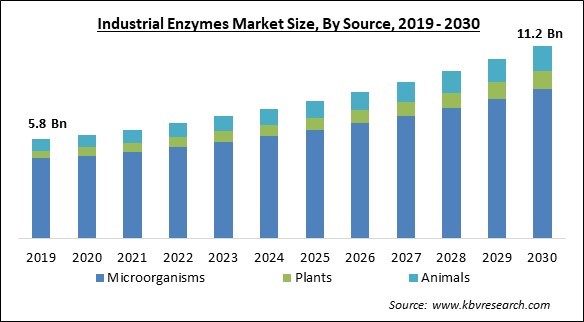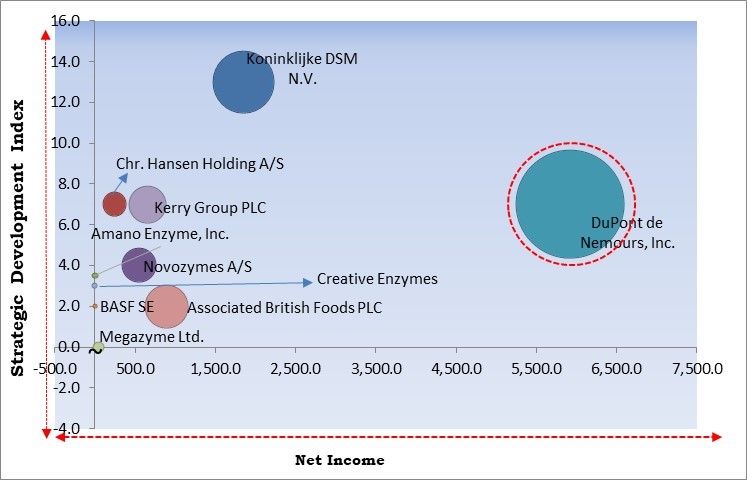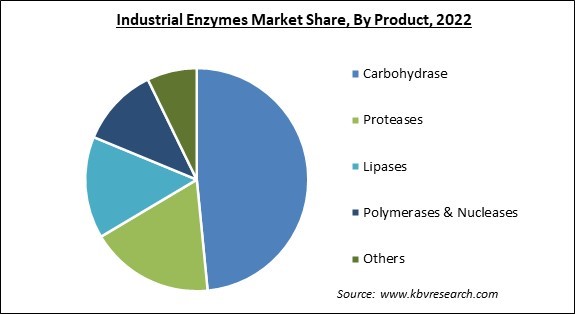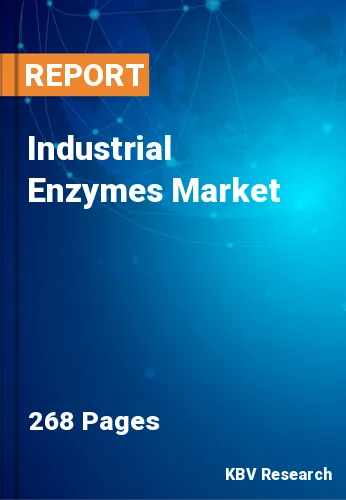The Global Industrial Enzymes Market size is expected to reach $11.2 billion by 2030, rising at a market growth of 6.7% CAGR during the forecast period.
The ever-expanding worldwide population and its rising purchasing power are primarily responsible for the growth of the food and beverage sector. Hence, the Food & Beverages sector would generate more than 15% share of the market by 2030. A frequent trend among today's consumers is the rising demand for meals with high natural flavor and taste standards. Due to this tendency, processed foods with flavor and taste had to be developed employing industrial enzyme applications. These enzymes function as catalysts by being critical in breaking vitamins and nutrients during metabolic reactions and the interconversion of complex molecules into simpler ones.
With sales of produced goods totaling $117.8 billion in 2019, the food and beverage processing business is the second-largest manufacturing sector in Canada, according to data from the Government of Canada. Similarly, India has one of the greatest food processing industries in the world, and by 2025–2026, Invest India estimates that it will produce $535 billion worth of food. The agri-food industry, according to the UK government, provided £116.2 billion, or 6%, of the country's Gross Value Added (GVA) in 2020.

The major strategies followed by the market participants are Product Launches as the key developmental strategy to keep pace with the changing demands of end users. For instance, In June, 2023, Kerry Group PLC launched Biobake EgR, an enzyme solution that reduces the number of eggs required in the baking process. The benefits of the product include a reduction of Co2 emissions by up to 14%. Additionally, In April, 2023, Creative Enzymes introduced detergent enzyme blend granules used for increasing the performance of laundry detergents. The product contains a mixture of lipase, amylase, protease, and mannanase. Additionally, the product is eco-friendly as it is made from natural sources.
Based on the Analysis presented in the KBV Cardinal matrix; DuPont de Nemours, Inc. are the forerunners in the Market. In November, 2019, DuPont de Nemours, Inc. introduced DuPont Danisco Nurica and DuPont Danisco Bonlacta. The DuPont Danisco Nurica is an enzyme used for lactose conversion. The benefits of the product include sugar reduction and lactose optimization. Companies such as Koninklijke DSM N.V., Associated British Foods PLC, Kerry Group PLC are some of the key innovators in the Market.

By merging some impending technologies of gene editing and innovative bacterial platforms for therapeutic enzymes, the increasing interest in employing enzymes for numerous industrial processes has sparked the quest for biocatalysts with new or enhanced features. With advancements in technology, it is now possible to change odd residues in a natural enzyme to create an improved enzyme with enhanced functional characteristics. Hence, the increasing number of R&D initiatives in industrial enzyme use is boosting the expansion of the market.
The demand is rising in response to the demand for renewable and ecological alternatives. Since fermented sugars are produced during enzymatic hydrolysis and then further fermented, enzymatic hydrolysis plays a significant role in the production of bioethanol. The advantages of using biotechnology-based enzymes over conventional chemicals and a way to deal with the problems caused by synthetic chemicals have long been acknowledged. Therefore, the rising demand for sustainable and renewable products and methods will propel the growth of the market throughout the forecast period.
Manufacturers of enzymes are required to adhere to the regulations that are imposed by various governing agencies, including the Enzyme Technical Association (ETA), the EU Registration, Evaluation, and Authorization of Chemicals (REACH) Regulation, and the Association of Manufacturers & Formulators of Enzyme Products (AMFEP). The Food Chemicals Codex provides a set of criteria that must be followed when enzymes are used in the food manufacturing business. Therefore, such strict regulatory rules may hamper the expansion of the market to some extent.
On the basis of source, the market is classified into microorganisms, plants, and animals. The plants segment recorded a significant revenue share in the market in 2022. The capacity of plant-based enzymes to meet particular allergies and dietary restrictions has led to an increase in demand for them. Plant-based enzymes are excellent substitutes for those who are lactose intolerant or who adhere to dietary restrictions that forbid substances originating from animals. Demand for plant-based enzymes has also increased due to consumer worries regarding product components. Due to their plant-based origins and lack of usage of GMOs or synthetic chemicals, they are regarded as clean-label ingredients.
Based on product, the market is characterized into carbohydrase, proteases, lipases, polymerases & nucleases, and others. The carbohydrase segment garnered the highest revenue share in the market in 2022. The expansion of the segment is due to its expanding application across a range of sectors, including, among others, the pharmaceutical, food & beverage, and animal feed industries. It is primarily utilized as a catalyst to transform carbohydrates into sugar syrups like fructose and glucose, which are then employed in the food and beverage, and pharmaceutical sectors. It is used to make prebiotic goods like isomaltose for wines and juices, as well as artificial sweeteners.

By application, the market is divided into food & beverages, biofuels, textiles, detergents, paper & pulp, personal care & cosmetics, wastewater, animal feed, agriculture, and others. The food and beverages segment witnessed the maximum revenue share in the market in 2022. The increased use of enzymes in manufacturing food and drink products is responsible for this growth. Both tailored enzyme solutions and exclusive enzyme products are used in processing cheese, vegetables, fruits, oils and fats, grains, and several other food products in the dairy, baking, and brewing industries. Lipases, carbohydrase, and proteases are the three enzymes most commonly used in the food and beverage industry.
| Report Attribute | Details |
|---|---|
| Market size value in 2022 | USD 6.7 Billion |
| Market size forecast in 2030 | USD 11.2 Billion |
| Base Year | 2022 |
| Historical Period | 2019 to 2021 |
| Forecast Period | 2023 to 2030 |
| Revenue Growth Rate | CAGR of 6.7% from 2023 to 2030 |
| Number of Pages | 268 |
| Number of Table | 444 |
| Report coverage | Market Trends, Revenue Estimation and Forecast, Segmentation Analysis, Regional and Country Breakdown, Competitive Landscape, Companies Strategic Developments, Company Profiling |
| Segments covered | Source, Product, Application, Region |
| Country scope | US, Canada, Mexico, Germany, UK, France, Russia, Spain, Italy, China, Japan, India, South Korea, Singapore, Malaysia, Brazil, Argentina, UAE, Saudi Arabia, South Africa, Nigeria |
| Growth Drivers |
|
| Restraints |
|
Region wise, the market is analyzed across North America, Europe, Asia Pacific, and LAMEA. The North America segment garnered the largest revenue share in the market in 2022. Due to a number of elements that support both enzyme producers and consumers in their commercial endeavors, the demand for industrial enzymes in North America is rising noticeably. Governments in this region have put supportive measures in place, including rules, subsidies, and tax incentives to encourage the use of sustainable technologies. Due to the governmental encouragement to use environmentally friendly products, such as enzymes, businesses are growing.
Free Valuable Insights: Global Industrial Enzymes Market size to reach USD 11.2 Billion by 2030
The market research report covers the analysis of key stake holders of the market. Key companies profiled in the report include Novozymes A/S (Novo Holdings A/S), DuPont de Nemours, Inc., Koninklijke DSM N.V., Chr. Hansen Holding A/S, Creative Enzymes, BASF SE, Kerry Group PLC, Associated British Foods PLC (Wittington Investments Limited), Amano Enzyme, Inc., and Megazyme Ltd. (Neogen Corporation)
By Application
By Source
By Product
By Geography
The Market size is projected to reach USD 11.2 billion by 2030.
R&D efforts to support the growing demand for enzyme applications are driving the Market in coming years, however, Strict regulatory rules for the manufacturing industry restraints the growth of the Market.
Novozymes A/S (Novo Holdings A/S), DuPont de Nemours, Inc., Koninklijke DSM N.V., Chr. Hansen Holding A/S, Creative Enzymes, BASF SE, Kerry Group PLC, Associated British Foods PLC (Wittington Investments Limited), Amano Enzyme, Inc., and Megazyme Ltd. (Neogen Corporation)
The expected CAGR of this Market is 6.7% from 2023 to 2030.
The Microorganisms segment is generating the highest revenue share in the Global Industrial Enzymes Market by Source in 2022, achieving a market value of $8.7 billion by 2030.
The North America market dominated the Global Industrial Enzymes Market by Region in 2022, achieving a market value of $3.9 billion by 2030.
Our team of dedicated experts can provide you with attractive expansion opportunities for your business.

